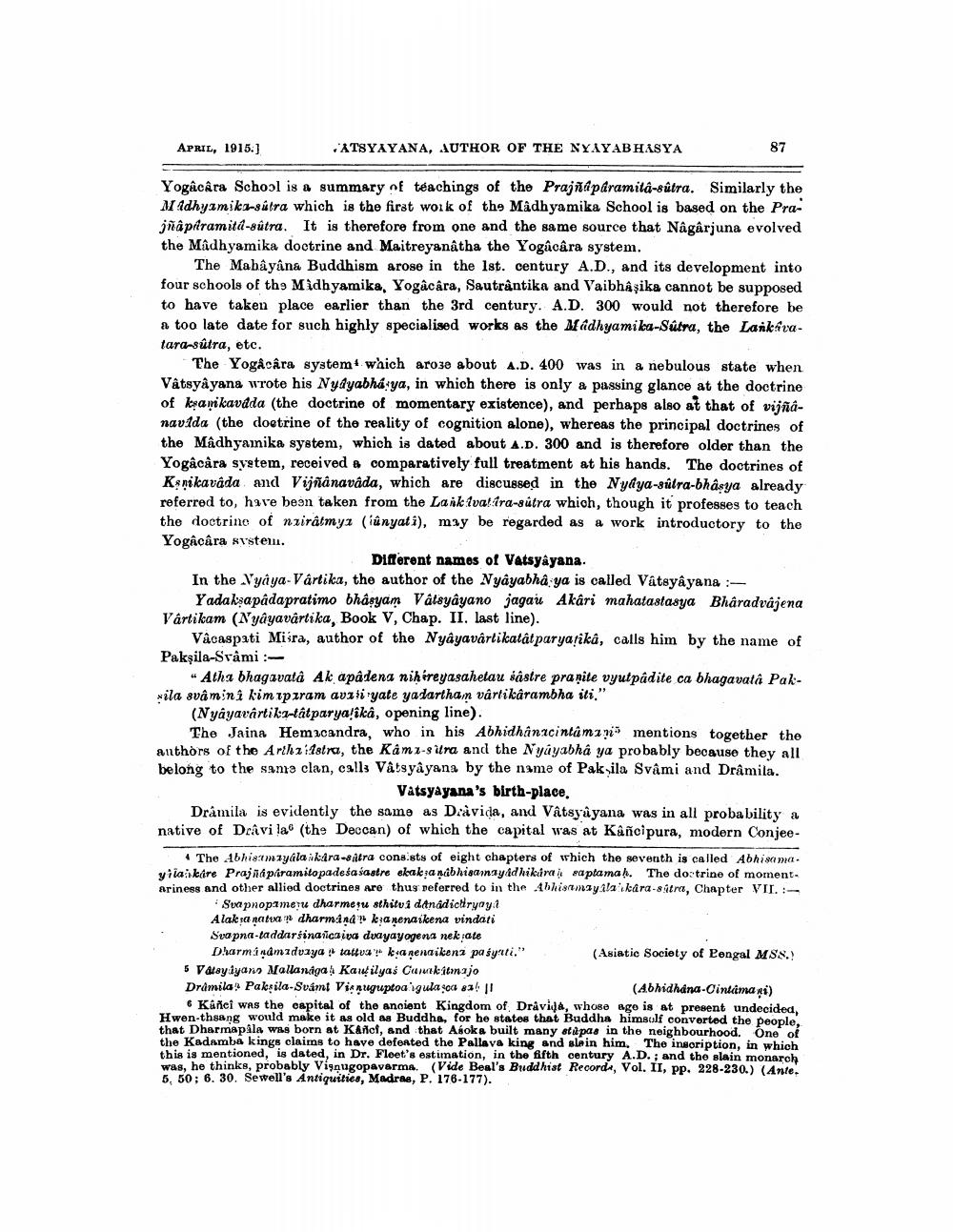________________
APRIL, 1915.)
ATSYAYANA, AUTHOR OF THE NYAYABHASYA
87
Yogâcâra School is a summary of teachings of the Prajnaparamita-sútra. Similarly the Madhyamika-sútra which is the first work of the Madhyamika School is based on the Prajñâ piiramita-sútra. It is therefore from one and the same source that Nagarjuna evolved the Madhyamika doctrine and Maitreyanatha the Yogâcâra system.
The Mabâvâna Buddhism arose in the 1st. century A.D., and its development into four schools of the Midhyamika, Yogâcâra, Sautrântika and Vaibhâșika cannot be supposed to have taken place earlier than the 3rd century. A.D. 300 would not therefore be a too late date for such highly specialised works as the Madhyamika-sútra, the Lankiratara-sútra, etc.
The Yogácâra system which arose about A.D. 400 was in a nebulous state when VAtsyâyana wrote his Nydyabhá ya, in which there is only a passing glance at the doctrine of kşam kavdda (the doctrine of momentary existence), and perhaps also at that of vijñanavida (the doctrine of the reality of cognition alone), whereas the principal doctrines of the Madhyainika system, which is dated about A.D. 300 and is therefore older than the Yogâcâra system, received a comparatively full treatment at his hands. The doctrines of Kanikaváda and Vijñânavada, which are discussed in the Nyaya-sútra-bhâsya already referred to have been taken from the Laikivatira-sútra which, though it professes to teach the doctrine of nziratmyz (únyati), may be regarded as a work introductory to the Yogâcâra system.
Different names of Vatsyâyana. In the Vyâya-Vartika, the author of the Nyayabha ya is called Vätsyâyana :
Yadak-apâdapratimo bhâsyam Vâtsyayano jagau Akari mahatastasya Bharadvajena Vartikam (Nyâyavartika, Book V, Chap. II. last line).
Vacaspati Mišra, author of the Nyâyavárlikatât paryarika, calls him by the name of Pakşila-Srâmi :
" Atha bhagavatâ Ak apádena nihéreyasahetau sastre pranite vyutpâdite ca bhagavatá Paknila svâmin i kimipiram avztiryate yadarthan vartikarambha iti."
(Nyayavartikutátparyalikâ, opening line).
The Jaina Hemicandra, who in his Abhidhanacintamaris mentions together the authors of the Arthz 11stra, the Kami-sira and the Nyayabha ya probably because they all belong to the same clan, calls Vâtsyâyana by the name of Paksila Svâmi and Drâmila.
Vatsyayana's birth-place. Drámila is evidently the same as Dravida, and Vâtsyâyana was in all probability a native of Dcâvila (the Deocan) of which the capital was at Kancipura, modern Conjee
The Abhisumayala ikdra-satra cons.sts of eight chapters of which the seventh is called Abhi sama viia kare Prajndpiramitopadesa jastre akak;a ncbhisannsyld hikira saptamal. The doctrine of moment. ariness and other allied doctrines Are thus referred to in the Abhinay laikara-8 stres, Chapter VII.
. Suapnopameru dharme u sthitvi danadichiryaya Alaksanatoa dharmand kanondikena vindati Svapna-taddarsinaicaiva dvayayogena nekate
Dharmindmadvaya tattu kanenaikeni paśyuti." (Asiatic Society of Bengal MSS. 5 Vatay iyano Nallanaga), Kawilyas Cuwkitonajo Drámila Paksila-Svámi Vinnuguptoaigula goa 83911
(Abhidhana-Cintamaxi) 6 Kanci was the capital of the ancient Kingdom of Drávida, whose ago is at present undecided, Hwen-thoang would make it as old as Buddha, for he states that Buddha himsulf converted the people. that Dharmapala was born at Kance, and that Asoka built many etapas in the neighbourhood. One of the Kadamba kings claims to have defented the Pallava king and slain him. The insoription, in which this is mentioned, is dated, in Dr. Floet's estimation, in the fifth century A.D.; and the slain monarch was, he thinks, probably Vígnugopavarma._ (Vide Beal's Buddhist Record-, Vol. II, pp. 228-230.) (Ante. 5, 50; 6. 30. Sewell's Antiquities, Madras, P. 176-177).




